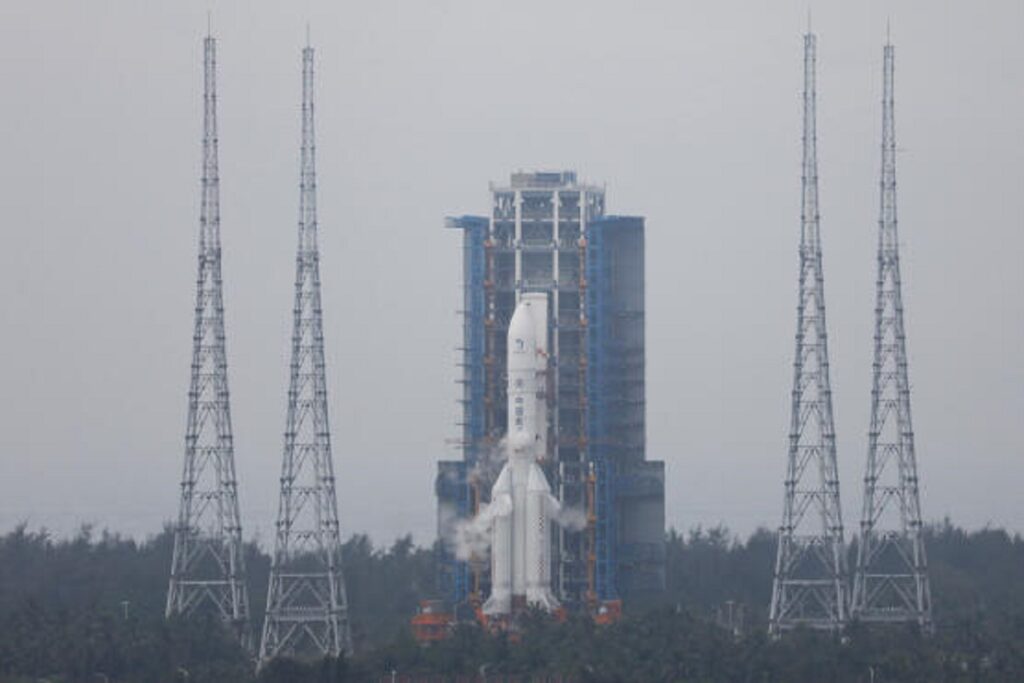On May 3, 2024, China successfully launched the Chang’e-6 probe, which landed on the dark side of the Moon to collect samples, marking a significant achievement for China’s ambitious space program. This mission, hailed by the Chinese state news agency, underscores China’s growing capabilities in space exploration, aiming to rival the United States.
A Historic Landing
The Chang’e-6 probe, which lifted off from the Wenchang Space Launch Center on Hainan Island, landed in the South Pole-Aitken Basin, one of the largest known impact craters in the solar system. This 53-day mission aims to collect the first samples from the Moon’s far side, an area less explored and shrouded in mystery.
I remember reading about the Apollo missions as a child, imagining astronauts bouncing around on the Moon’s surface. Now, thinking about Chang’e-6 landing on the Moon’s dark side feels like a scene from a sci-fi novel come to life.
Precision and Challenges in Landing
The probe descended from its orbit, approximately 200 kilometers above the Moon, to scout for a landing site. Huang Wu, a representative from the China Aerospace Science and Technology Corporation (CASC), explained on CCTV that the descent involved precise control procedures to place the probe on its predetermined path. “We had to rapidly reduce the probe’s relative speed to the Moon to zero within fifteen minutes, requiring a significant amount of propellant, almost half the probe’s total weight,” Huang Wu detailed.
The probe’s mission includes collecting lunar material and conducting experiments in its landing area. Equipped with a drill to retrieve subsurface samples and a robotic arm for surface material, Chang’e-6 is expected to complete these tasks within two days. The small module containing the samples will then attempt to return from the Moon’s far side.
The Promise of Lunar Exploration
In 2019, China successfully landed a probe on the Moon’s far side, but it did not return with samples. Scientists believe this side of the Moon, less covered by ancient lava flows, holds ancient samples that could provide insights into the Moon’s formation.
Ge Ping, the deputy director of the China Lunar Exploration and Space Engineering Center, noted, “The samples collected by Chang’e-6 are estimated to be about 4 billion years old.”
China’s Growing Space Ambitions
Under President Xi Jinping, China has significantly advanced its space programs, investing billions to close the gap with the United States. Notable achievements include the construction of the Tiangong space station, where a new crew of three astronauts arrived in April, and landing a rover on Mars. China is also the third country to send a human into space independently.
Looking ahead, China aims to send a manned mission to the Moon by 2030 and plans to build a lunar base.
A New Space Race?
China’s rapid progress in space exploration has raised concerns in Washington. In April, NASA Administrator Bill Nelson remarked that the U.S. is in a “race” with China. He expressed concerns that much of China’s so-called civil space program is, in reality, military.
The idea of another space race, this time between China and the U.S., brings to mind the Cold War era. Growing up, stories of the space race were thrilling tales of innovation and competition. It seems we might be witnessing a new chapter in space exploration history.
As the Chang’e-6 probe continues its mission, the world watches closely, anticipating the valuable data and samples it will bring back, contributing to our understanding of the Moon and beyond.

